For Whom the Bell Tolls
The remediation of a bell tower presumed contaminated by pathogenic fungi (Histoplasma capsulatum); a multidisciplinary approach.
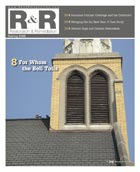
While significant medical controversy exists over the potential for water-related fungal contamination of indoor environments to cause health problems, there is medical confirmation that the fecal matter of feral birds – pigeons and starlings – and bats harbor harmful pathogens, which are a threat to human health.
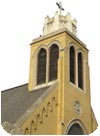 Let’s dissect the remediation of a church bell tower that was home to a colony of pigeons. The interior of the bell tower was fouled and contaminated by bird droppings and presumed to be a reservoir of human pathogens. The remediation was performed to prevent the situation from worsening and to provide a safe work area for roofers performing repair work in the bell tower. The remediation of the bell tower was a multifaceted project involving: research, planning, design and implementation and safety concerns.
Let’s dissect the remediation of a church bell tower that was home to a colony of pigeons. The interior of the bell tower was fouled and contaminated by bird droppings and presumed to be a reservoir of human pathogens. The remediation was performed to prevent the situation from worsening and to provide a safe work area for roofers performing repair work in the bell tower. The remediation of the bell tower was a multifaceted project involving: research, planning, design and implementation and safety concerns.
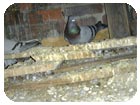
Feral pigeons, due to their innate ability to adapt to manmade environments, are the most troublesome birds in urban environments3, opportunistic colonizers who readily take advantage of structural design or architectural features that provide shelter, roosting, nesting and loafing places for them.
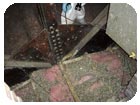 Access to the exterior surfaces of buildings can be challenging, so exterior building repair and maintenance is often deferred. Deferred maintenance often provides opportunities for pigeons to gain entry into the interior of buildings. Pigeons will eat seeds, berries and scavenge garbage cans, and may obtain water from a variety of sources including open cisterns. When food and water are unavailable near their nesting areas, pigeons will seek and source these necessities within their flight range. Pigeons have few natural predators in the urban environment. When able to nest indoors pigeons often breed continuously laying eggs up to six times per year. Mass nesting is common a common behavior pattern.
Access to the exterior surfaces of buildings can be challenging, so exterior building repair and maintenance is often deferred. Deferred maintenance often provides opportunities for pigeons to gain entry into the interior of buildings. Pigeons will eat seeds, berries and scavenge garbage cans, and may obtain water from a variety of sources including open cisterns. When food and water are unavailable near their nesting areas, pigeons will seek and source these necessities within their flight range. Pigeons have few natural predators in the urban environment. When able to nest indoors pigeons often breed continuously laying eggs up to six times per year. Mass nesting is common a common behavior pattern.
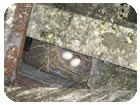 Bird pressure is the term used to refer the attachment or commitment pigeons have to sites. The greater the attachment birds have to a site, the more difficult it will be evict them. Light-attachment sites are those where birds can “either take it or leave it.” Medium-attachment sites are those closer to regular food sources where birds spend time on daily basis. High-attachment sites are those where birds are nesting, incubating eggs or raising young; high-attachment sites may have been home for generations.
Bird pressure is the term used to refer the attachment or commitment pigeons have to sites. The greater the attachment birds have to a site, the more difficult it will be evict them. Light-attachment sites are those where birds can “either take it or leave it.” Medium-attachment sites are those closer to regular food sources where birds spend time on daily basis. High-attachment sites are those where birds are nesting, incubating eggs or raising young; high-attachment sites may have been home for generations.
Pigeon droppings deface buildings and due to its acidic chemical nature accelerate degradation of building materials. The structural deterioration and subsequent collapse of the I-35 bridge in Minneapolis, Minn. in which four fatalities and 79 injuries were suffered has been attributed to chemical degradation of structural components caused by pigeons4. Shed pigeon feathers, nesting materials and droppings may clog gutters, downspouts causing water damage, air intakes and often fall where people walk or work. Bird droppings can be slippery and have caused trip and fall accidents. Bird droppings can be tracked into buildings bringing soil and pathogens inside. Cleanup of bird droppings is an ongoing maintenance expense.
Previous guidance documents have approached the challenge more narrowly from medical and worker protection perspectives5. The purpose of this document is to provide broader cleaning and remediation guidance.
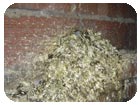
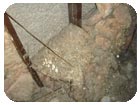 The cleaning professionals were responsible for selecting the tools, equipment and chemistries required for the project. Microbial remediation professionals would employ administrative and engineering controls in devising and implementing low-dust generation remedial techniques and cross-contamination prevention strategies. The pest control professional was responsible for: researching target specie’s habits and life cycle, control and exclusion methods and applicable legal issues. The team’s health and safety professional was responsible for evaluating the risks posed to workers and ensuring that workers had the needed safety training, selection of suitable personal protective equipment, ensuring that workers were medically fit to wear the PPE, and monitoring potential internal emissions of contaminate during the work process. The construction contractor conceived and constructed suitable containment barriers, scaffolding and work platform. The roofing contractor made exterior repairs and installed the pigeon deterrent apparatus.
The cleaning professionals were responsible for selecting the tools, equipment and chemistries required for the project. Microbial remediation professionals would employ administrative and engineering controls in devising and implementing low-dust generation remedial techniques and cross-contamination prevention strategies. The pest control professional was responsible for: researching target specie’s habits and life cycle, control and exclusion methods and applicable legal issues. The team’s health and safety professional was responsible for evaluating the risks posed to workers and ensuring that workers had the needed safety training, selection of suitable personal protective equipment, ensuring that workers were medically fit to wear the PPE, and monitoring potential internal emissions of contaminate during the work process. The construction contractor conceived and constructed suitable containment barriers, scaffolding and work platform. The roofing contractor made exterior repairs and installed the pigeon deterrent apparatus.
Objectives for the project included:
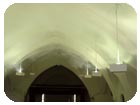
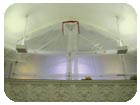
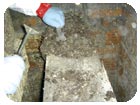
An entry hatch into the bell tower was present in the choir loft/balcony. Due to its location, the opposing side of the entry hatch was presumed to be heavily contaminated with pigeon feces and other contaminates. As the remediation team was unsure as to the level of contamination, the size of the pigeon colony and the team wanted to minimize the risk for pigeon feces and other contaminates to fall down on them, to minimize the risk of cross contaminating the church choir loft and sanctuary and other relevant considerations it was decided to seek an alternate point from which to access the attic. To reconnoiter the situation and conditions in the bell tower access to the area was gained by using an entrance hatch at the opposite end of the church attic approximately 85 feet away. Had an alternative access to the attic been unavailable for risk management purposes a new access opening would have been made in an area presumed to be less contaminated.
To reconnoiter the bell tower, the reconnaissance team donned PPE (respiratory protection, disposable coveralls, shoe covers and nitrile gloves) and toting flashlights, a smoke emitting pencil and a camera carefully made their way through the attic. The team walked across the supporting wooden superstructure being careful to circumnavigate obstacles while not stepping or falling through the plaster ceiling. While working their way to and from the bell tower the team took photographs and used the smoke pencil to monitor airflow patterns.
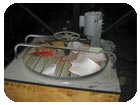 The vast majority of the pigeon infestation and related contamination was found within the bell tower. Some fecal contamination was visible at the juncture where the bell tower joins the attic. The interior of the bell tower has two levels, a smaller upper loft where the church bells formerly resided and a main bell tower structure framed by wooden ventilation louvers on all four sides. The interior dimensions of the upper level are 7.5-by-7-by-7 feet. The interior dimensions of the lower level are 10-by-7-by-7 feet. The primary interior surface of the bell tower is exposed masonry, some structural steel and wooden materials are also present.
The vast majority of the pigeon infestation and related contamination was found within the bell tower. Some fecal contamination was visible at the juncture where the bell tower joins the attic. The interior of the bell tower has two levels, a smaller upper loft where the church bells formerly resided and a main bell tower structure framed by wooden ventilation louvers on all four sides. The interior dimensions of the upper level are 7.5-by-7-by-7 feet. The interior dimensions of the lower level are 10-by-7-by-7 feet. The primary interior surface of the bell tower is exposed masonry, some structural steel and wooden materials are also present.
Scores of adult pigeons were present along with juvenile pigeons, nests and eggs and the skeletal remains of adult and juvenile pigeons. Presence of the skeletal remains was apparently not a deterrent to colonization. The pigeons had gained access to the bell tower by squeezing through wooden louvers in bell tower. With persistent efforts the birds were able to force their way past the insect and bird restraint screening installed on the interior face of the louvers. Frequent entrée and exit by pigeons over time sufficiently widened the opening to allow access at will. Flying insects were airborne and beetles were visible crawling in the fecal matter.
Varying levels of fecal contamination was found on both vertical and horizontal surfaces within the bell tower and in the adjacent attic spaces. Extensive fecal contamination was found on horizontal surfaces in some areas 10- to 14-inches thick. Other contaminates included: feathers, nesting material, insulation, and construction debris. Noticeable ammonia odor attributed to bird fouling was prevalent within the bell tower.
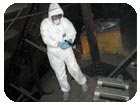
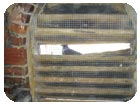
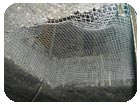
Area containment. It was determined that using a double containment would be the best way of preventing cross contamination and minimizing worker exposure to contaminates. The entire choir loft/balcony was set up as a negative pressure full containment prior to any further access to the area. Within the full containment, a second mini (local) containment was established on the specially designed scaffolding built under the access to the bell tower. To monitor air pressure differentials within the containment structure a digital recording manometer would be utilized.
A sturdy containment barrier wall was designed and constructed using 1-inch diameter PVC pipe, PVC pipe fittings, 6-mil medium-slip fire retardant polyethylene plastic film, aerosol cans of spray adhesive, and zipper doors. The containment structure was engineered to fit within the curved contour of the archway, effectively segregating the choir loft from the main sanctuary of the church. PVC pipe cutters were used to cut the PVC pipe, pipe cutters are more efficient and don’t shed plastic fragments during cutting. Makeup air for the containment area was provided by an adjustable size opening left in the containment wall at the top of the archway. The containment wall was designed to withstand in excess of the ≥ -6 pascals of negative pressure differential it would be subjected to.
The choir loft/balcony is located at the rear of the sanctuary and is accessed by walking down a hallway, past two washrooms and walking up a stairway. The entrance opening to the hallway was covered with plastic film in which a zipper door installed, thereby effectively segregating the hallway, the two washrooms, stairwell and choir loft/balcony from the sanctuary.
Air filtration devices. To minimize the risk of cross contamination air filtration devices were utilized to maintain the containment structure (balcony/choir loft) under negative pressure. Two air filtration devices rated at processing a total of 5,500 cfm were utilized to maintain the (balcony/choir loft) work area under negative pressure. An additional air filtration device (2,000 cfm) was operated in the work area (balcony/choir loft) in air cleaning and recirculation mode. One air filtration device (1,000 cfm) was operated within the mini containment on the work platform in an air cleaning & recirculation mode.
Washroom and worker decontamination chambers. Conveniently two existing washroom facilities were located in the hallway adjacent to the stairwell leading upstairs to the choir loft. The washrooms served multiple purposes: washroom, first aid station and worker decontamination chambers (where workers would remove contaminated coveralls and safety equipment prior to exiting containment).
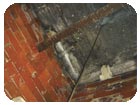
A variety of pest management techniques exist for dealing with pigeons:
Habitat modification. Techniques such as removal of food and water sources, the pruning or trimming of tree limbs makes them unavailable or less desirable as roosting or nesting places were not applicable to our project.
Exclusion. In new construction, the superior solution to potential pigeon problems is to deny them access by “engineering and designing buildings to be as bird proof or bird resistant as possible.” In existing structures the use of deterrents and the adherence to a strict regimen of exterior building maintenance are useful tools in prevention of nuisance bird problems. Wire coils, spikes, netting, electric shock, chemical repellent are some tools commonly used to dissuade pigeon colonization.
Other methods. Harassment and intimidation methods such as nest destruction, loud noise, recorded bird distress calls and plastic predatory birds have proven limited in discouraging pigeon colonization. Live trapping and euthanasia of trapped pigeons, chemical control methods like taste-aversion compounds, hallucinogenic and toxic baits, and shooting are considerations.
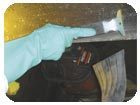
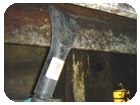
Erecting a mini-containment structure on the work platform. Workers placed two layers of poly film on the floor of the floor of the work platform, a 1,000 cfm air filtration device on the platform and then used telescoping poles to create four walls by pressure fitting poly film to the ceiling. The poly film walls were erected for the purpose of limiting potential cross contamination from the bell tower from escaping preventing cross contamination.
Opening the hatch. Once the entry hatch was preliminarily decontaminated it was removed, double bagged and passed down to a worker on the work platform who stowed it for future use.
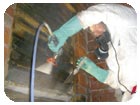
Harassment. Over 100 adult birds were startled and harassed out of the building with sharp cracking sounds made by striking short pieces of lumber against one another.
Exclusion. The wooden louvers through which the pigeons gained and entrance and exited the building were repaired and then metal screening was stapled to deny access to the pigeons.
Eradication. Feral pigeons are neither endangered nor protected avian species. While the majority of the colony was humanely ousted, the use of some lethal force was inevitable. The remaining adult bird population was dispatched by a marksman with a compressed-gas-powered pellet gun, and the young by neck-breaking. With the aid of a grabber reaching device carcasses were removed and bagged.
Deterrent. Sharp spikes were strategically installed onto the building roof and other pigeon loafing places by the roofing contractor.
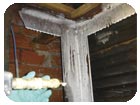
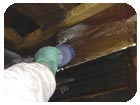
As a dust-control measure (engineering control) prior to commencement of full-scale remediation operations, structural surfaces and accumulated pigeon droppings were “locked down” with a coating of an aqueous film-forming tackifier in which an antifungal agent was incorporated. The dried film was designed to be removable with detergent and water. Beginning in the upper level of the bell tower and progressing downward a top-to-bottom application of the tackifier was made.
Utility requirements. Natural light shone into the lower level of the bell tower, natural light was augmented by fluorescent trouble lights and a rugged Wobble Light. 12-gauge electrical cords were used to run power into the bell tower. Cords were routed and secured in a manner to maximize safety and resist disconnection. Ground fault circuit interrupters (GFCIs) were utilized due to moisture exposure.
Natural ventilation entered the bell tower through the louvers. The 1,000-cfm air filtration device on the work platform provided adequate air cleansing within the bell tower.
Gross contamination removal, rough cleaning. Working in an orderly fashion from top to bottom, garden sprayers, a foam generator and/or an airless paint sprayer were used to wet accumulated piles of pigeon droppings with QAC (quaternary ammonium compound) cleaner disinfectant solution prior to and during removal. A disinfectant cleaner was selected due its antimicrobial properties and because its surface penetration capabilities exceeded that of water. A conscious decision was made by the team to rely on source removal and thorough wet cleaning to decontaminate contaminated materials rather than rely on a significantly more hazardous liquid sterilant (formaldehyde or glutaraldehyde) to attempt to kill pathogenic fungal spores7.
Contaminate was wetted prior to bulk removal and continually during removal. In diminishing order: shovels, dustpans, brooms, wire brushes, scraping tools (putty knives and molding paint scrapers) and vacuums were used to remove bulk contaminates. A dry canister vacuum which collected contaminate in disposable bags was selected to avoid unnecessary handling of the contaminated materials.
Bagging debris, handling debris and storing debris. Debris was accumulated and placed into doubled heavy-duty plastic bags. To prevent opening from the tops the tops of both bags were twisted folded over and taped (J-wrapped). Bags were damp-wiped with cleaner disinfectant on the work platform, damp-wiped with cleaner disinfectant prior to being stored on the balcony and damp-wiped prior to being taken out of containment and placed in the dumpster.
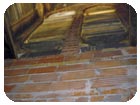 The four-step decontamination procedure. A four-step procedure was utilized to decontaminate the bell tower.
The four-step decontamination procedure. A four-step procedure was utilized to decontaminate the bell tower.
Step 1 involved initial dust-control application of the aqueous tackifier and wetting with disinfectant cleaner solution during and the bulk removal of the contaminated material.
Step 2 was combined dry and wet cleaning techniques in which visible remnants of contaminate were removed. Visible contaminate was dampened with the cleaner disinfectant solution via: garden sprayer, foam generator or airless paint sprayer. Scrapers (paint scrapers and putty knives) and wire brushes were used to dislodge debris pre-softened by wet spraying. Plastic brushes were used to work cleaner disinfectants solution into structural surfaces. Loosened debris and spent solution were recovered by vacuum. Vacuum hose (1½-inch diameter) clogged frequently, the value and superiority of larger diameter vacuum hose (3 to 5-inch diameter) was evident. Pressure on the airless paint sprayer was adjusted downward (approximately 400-500 PSI) to allow the device to be used as a low volume moderate pressure-cleaning device.
Step 3 was a wet cleaning of all affected areas using either an airless paint sprayer or residential pressure washer. Plastic film was placed on the floor of the bell tower to accumulate spent liquid solution.
Step 4. Using the airless paint sprayer, all exposed surfaces were encapsulated with an aqueous tackifier with antifungal additive.
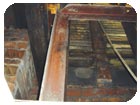
The remediation work practices designed and implemented for decontaminating the interior of the bell tower were proven to be highly successful under demanding circumstances. The physical appearance of the interior of the bell tower is high, the bell tower is odor-free, and particle counts within the bell tower are equal to or below particle counts outdoors.
We would like to thank those individuals who, in addition to the authors, participated in the project: Gary Funari, who designed and built the barrier wall; William Weigand who served as a crew leader; Alan Goebel who provided support to the workers; Zachary Zlotnik, our photographer, and Paul McMahon.
1 Handbook of Pest Control, ninth edition Arnold Mallis, Editorial Director Stoy Hedges
2 Handbook of Pest Control, ninth edition Arnold Mallis, Editorial Director Stoy Hedges
3 Handbook of Pest Control, ninth edition Arnold Mallis, Editorial Director Stoy Hedges
4 Foul Play? Officials investigating the deadly Minneapolis bridge collapse are looking at an unlikely culprit: pigeons, by Eve Conant, Newsweek Web Exclusive, Aug 25, 2007
5 Hisoplasmosis, protecting workers at risk, NIOSH, 1007, revised 2004
6 Wheat J [1997]. Hitsoplasmosis: experience during outbreaks in Indianapolis and review of the literature. Med. 76:339-354
7 Hisoplasmosis, protecting workers at risk, NIOSH, 1007, revised 2004

While significant medical controversy exists over the potential for water-related fungal contamination of indoor environments to cause health problems, there is medical confirmation that the fecal matter of feral birds – pigeons and starlings – and bats harbor harmful pathogens, which are a threat to human health.


Vectors of Histoplasmosis - Bats, Pigeons and Starlings
The health threat posed by pigeons is unmatched by any other bird species. 1 Pigeons carry or transmit pigeon ornithosis, encephalitis, Newcastle disease, histoplasmosis, cryptococcosis, toxoplasmosis, pseudo-tuberculosis, pigeon coccidiosis, and salmonella food poisoning. Pigeon ectoparisites include chewing lice, fleas, ticks and mites, some of which bite humans (e.g. northern fowl mite) 2.Feral pigeons, due to their innate ability to adapt to manmade environments, are the most troublesome birds in urban environments3, opportunistic colonizers who readily take advantage of structural design or architectural features that provide shelter, roosting, nesting and loafing places for them.


Pigeon droppings deface buildings and due to its acidic chemical nature accelerate degradation of building materials. The structural deterioration and subsequent collapse of the I-35 bridge in Minneapolis, Minn. in which four fatalities and 79 injuries were suffered has been attributed to chemical degradation of structural components caused by pigeons4. Shed pigeon feathers, nesting materials and droppings may clog gutters, downspouts causing water damage, air intakes and often fall where people walk or work. Bird droppings can be slippery and have caused trip and fall accidents. Bird droppings can be tracked into buildings bringing soil and pathogens inside. Cleanup of bird droppings is an ongoing maintenance expense.
Previous guidance documents have approached the challenge more narrowly from medical and worker protection perspectives5. The purpose of this document is to provide broader cleaning and remediation guidance.

A Multifaceted Approach
A cleaning and remediation project where the presence of pathogenic fungi is presumed present is a complex and multifaceted task for which varied expertise will be required. The remediation team for the project was comprised of individuals whose diverse skill sets included: cleaning professionals, microbial remediation professionals, pest control professional, health and safety professional, construction contractor and roofing contractor.
Objectives for the project included:
- Remove and disperse the pigeon colony.
- Exclude pigeons from using former pathways to enter the building
- Eliminate pigeons that resist our displacement efforts.
- Make the building resistant to future pigeon colonization.
- Safely remove and dispose of the contaminant in a manner that minimizes the potential for cross contamination either inside or outside the building.
- Decontaminate the affected areas.
- Share our learning experience with others.

The Mother of Sorrows
The Mother of Sorrows church is a brick masonry building constructed in 1929. After being decommissioned as a church, the building served as a short stint as a senior citizen center. The property was sold in 2002, and since 2003 the building has been used as a trade school where students study fire and water damage repair; mold remediation; sewage intrusion cleanup and odor removal methods. The pigeon problem was ongoing, presumed to have existed for more than 5 years.
Project Planning
Communication with the owner during all phases of this type of project is vital. The building owner was closely involved throughout the project including participating in the planning process. The building owner was a member of the reconnaissance team that made the initial assessment of the situation. This proved to be extremely helpful in determining how to handle the numerous health and safety issues that are an inherent part of this type of remediation project. In particular the owner was able to assist in determining current building-use patterns, electrical safety issues (de-energized systems were present), make known the purpose and operational status of the large ventilation fans in the attic, disclose his plans and scheduling for repairs to louvers within and the roof on the bell tower, provide information about fire alarms, smoke detectors and the location of fire extinguishers, locate utilities and recommend suitable decontamination facilities for employees, etc.
Reconnaissance
As the situation within the bell tower was unknown it was necessary to reconnoiter the bell tower prior to developing and implementing the work plan. Key information which impacted the project needed to be obtained such as: determining the level of contamination, the number of pigeons, structural stability, electrical safety, requirement for confined space entry program, fall protection, electrical safety, engineering control design, and other relevant conditions.An entry hatch into the bell tower was present in the choir loft/balcony. Due to its location, the opposing side of the entry hatch was presumed to be heavily contaminated with pigeon feces and other contaminates. As the remediation team was unsure as to the level of contamination, the size of the pigeon colony and the team wanted to minimize the risk for pigeon feces and other contaminates to fall down on them, to minimize the risk of cross contaminating the church choir loft and sanctuary and other relevant considerations it was decided to seek an alternate point from which to access the attic. To reconnoiter the situation and conditions in the bell tower access to the area was gained by using an entrance hatch at the opposite end of the church attic approximately 85 feet away. Had an alternative access to the attic been unavailable for risk management purposes a new access opening would have been made in an area presumed to be less contaminated.
To reconnoiter the bell tower, the reconnaissance team donned PPE (respiratory protection, disposable coveralls, shoe covers and nitrile gloves) and toting flashlights, a smoke emitting pencil and a camera carefully made their way through the attic. The team walked across the supporting wooden superstructure being careful to circumnavigate obstacles while not stepping or falling through the plaster ceiling. While working their way to and from the bell tower the team took photographs and used the smoke pencil to monitor airflow patterns.

Scores of adult pigeons were present along with juvenile pigeons, nests and eggs and the skeletal remains of adult and juvenile pigeons. Presence of the skeletal remains was apparently not a deterrent to colonization. The pigeons had gained access to the bell tower by squeezing through wooden louvers in bell tower. With persistent efforts the birds were able to force their way past the insect and bird restraint screening installed on the interior face of the louvers. Frequent entrée and exit by pigeons over time sufficiently widened the opening to allow access at will. Flying insects were airborne and beetles were visible crawling in the fecal matter.
Varying levels of fecal contamination was found on both vertical and horizontal surfaces within the bell tower and in the adjacent attic spaces. Extensive fecal contamination was found on horizontal surfaces in some areas 10- to 14-inches thick. Other contaminates included: feathers, nesting material, insulation, and construction debris. Noticeable ammonia odor attributed to bird fouling was prevalent within the bell tower.

Prerequisite for Project Sequencing
Consideration of health and safety issues was the prerequisite for project sequencing. Relevant issues included and were not limited to: Hazard Communication; Worker Training; Medical Evaluation; Personal Protective Equipment; Confined Space Entry; Slip, Trips & Falls; Fall Protection; Heat Disorders; Electrical Safety; Ladder Safety; Scaffolding; Emergency Planning; Sanitation & Hygiene, etc. It was determined that all workers were physically fit and had medical evaluations (one worker was dismissed as unfit due to a recent bout of pleurisy.) All workers were FIT-tested on site to ensure that their respiratory protection was fitting properly.
External Cross Contamination Avoidance
Due to the known health risks caused by of external cross contamination it was considered irresponsible to exhaust dusts outdoors.6 The project would utilize containment barriers and negative air pressurization to protect indoor and outdoor environments.
Project Sequencing
Work platform. The remediation team determined that a suitable work platform would be required, through which the team would gain access to the contaminated area, stage their equipment, temporarily store debris, etc. For safety and efficiency reasons sections of scaffolding were installed parallel, resulting in a doublewide work area. The use of scaffolding required special safety precautions including and not limited to: installation of a 4-foot high safety railing, use of kick plate to prevent falling tools or debris from injuring anyone below, harness and fall protection for workers stationed on the work platform, selecting the proper length access ladder and properly securing the ladder for access to the work platform, securing and stowing electrical power cords, etc. The scaffolding and work platform is 10-by-5-by-12 feet.Area containment. It was determined that using a double containment would be the best way of preventing cross contamination and minimizing worker exposure to contaminates. The entire choir loft/balcony was set up as a negative pressure full containment prior to any further access to the area. Within the full containment, a second mini (local) containment was established on the specially designed scaffolding built under the access to the bell tower. To monitor air pressure differentials within the containment structure a digital recording manometer would be utilized.
A sturdy containment barrier wall was designed and constructed using 1-inch diameter PVC pipe, PVC pipe fittings, 6-mil medium-slip fire retardant polyethylene plastic film, aerosol cans of spray adhesive, and zipper doors. The containment structure was engineered to fit within the curved contour of the archway, effectively segregating the choir loft from the main sanctuary of the church. PVC pipe cutters were used to cut the PVC pipe, pipe cutters are more efficient and don’t shed plastic fragments during cutting. Makeup air for the containment area was provided by an adjustable size opening left in the containment wall at the top of the archway. The containment wall was designed to withstand in excess of the ≥ -6 pascals of negative pressure differential it would be subjected to.
The choir loft/balcony is located at the rear of the sanctuary and is accessed by walking down a hallway, past two washrooms and walking up a stairway. The entrance opening to the hallway was covered with plastic film in which a zipper door installed, thereby effectively segregating the hallway, the two washrooms, stairwell and choir loft/balcony from the sanctuary.
Air filtration devices. To minimize the risk of cross contamination air filtration devices were utilized to maintain the containment structure (balcony/choir loft) under negative pressure. Two air filtration devices rated at processing a total of 5,500 cfm were utilized to maintain the (balcony/choir loft) work area under negative pressure. An additional air filtration device (2,000 cfm) was operated in the work area (balcony/choir loft) in air cleaning and recirculation mode. One air filtration device (1,000 cfm) was operated within the mini containment on the work platform in an air cleaning & recirculation mode.
Washroom and worker decontamination chambers. Conveniently two existing washroom facilities were located in the hallway adjacent to the stairwell leading upstairs to the choir loft. The washrooms served multiple purposes: washroom, first aid station and worker decontamination chambers (where workers would remove contaminated coveralls and safety equipment prior to exiting containment).

Pest Management
In the United States, pest management and control is a regulated profession. Pest control operators are licensed by the states in which they work. The first step in managing the avian pest problem was observation. In existing structures it is imperative to determine how and where pigeons are entering the building and develop and utilize suitable methods to exclude them. In some situations the openings through which pigeons enter the building are visible and in other situations the entry points may be concealed. Binoculars can be a useful tool during observation.A variety of pest management techniques exist for dealing with pigeons:
Habitat modification. Techniques such as removal of food and water sources, the pruning or trimming of tree limbs makes them unavailable or less desirable as roosting or nesting places were not applicable to our project.
Exclusion. In new construction, the superior solution to potential pigeon problems is to deny them access by “engineering and designing buildings to be as bird proof or bird resistant as possible.” In existing structures the use of deterrents and the adherence to a strict regimen of exterior building maintenance are useful tools in prevention of nuisance bird problems. Wire coils, spikes, netting, electric shock, chemical repellent are some tools commonly used to dissuade pigeon colonization.
Other methods. Harassment and intimidation methods such as nest destruction, loud noise, recorded bird distress calls and plastic predatory birds have proven limited in discouraging pigeon colonization. Live trapping and euthanasia of trapped pigeons, chemical control methods like taste-aversion compounds, hallucinogenic and toxic baits, and shooting are considerations.

Bell Tower Contamination Characteristics
Vertical surfaces due to their orientation are inherently and initially resistant to accumulation of bird droppings. Accumulation of bird droppings on vertical surfaces results in protruding contamination of increased surface area the base for further accumulation. The vast majority of bird droppings accumulate on horizontal surfaces. Dried droppings harden to concrete-like consistency and stubbornly adhere to surfaces. The accumulated droppings from long term colonization and/or large pigeon colonies can vary from several inches to several feet thick.
Access Preparations
Preparing to open the hatch. The side of the entry hatch facing into the bell tower was covered with a significant accumulation of bird droppings and other contaminates. To reduce the bulk quantity of contamination prior to opening the entry hatch, the work team gained access to the bell tower from the rear attic hatchway. Workers used a compression garden sprayer to wet contaminates with amended water (aqueous cleaner disinfectant solution) prior to removal with hand tools and double bagging.Erecting a mini-containment structure on the work platform. Workers placed two layers of poly film on the floor of the floor of the work platform, a 1,000 cfm air filtration device on the platform and then used telescoping poles to create four walls by pressure fitting poly film to the ceiling. The poly film walls were erected for the purpose of limiting potential cross contamination from the bell tower from escaping preventing cross contamination.
Opening the hatch. Once the entry hatch was preliminarily decontaminated it was removed, double bagged and passed down to a worker on the work platform who stowed it for future use.

Management Techniques Employed
Through observation it was determined the bell tower was a high-attachment site and that modifying behavior patterns would be extremely challenging. The following avian pest management techniques were utilized for this project:Harassment. Over 100 adult birds were startled and harassed out of the building with sharp cracking sounds made by striking short pieces of lumber against one another.
Exclusion. The wooden louvers through which the pigeons gained and entrance and exited the building were repaired and then metal screening was stapled to deny access to the pigeons.
Eradication. Feral pigeons are neither endangered nor protected avian species. While the majority of the colony was humanely ousted, the use of some lethal force was inevitable. The remaining adult bird population was dispatched by a marksman with a compressed-gas-powered pellet gun, and the young by neck-breaking. With the aid of a grabber reaching device carcasses were removed and bagged.
Deterrent. Sharp spikes were strategically installed onto the building roof and other pigeon loafing places by the roofing contractor.

Insect Infestation and Preliminary Decontamination
An ultra-low-volume fogging device and a compression sprayer were used to treat the air spaces and structural surfaces within the bell tower. The insecticide of choice was a proprietary formulation combining synergized pyrethrum (a botanically based insecticide derived from Chrysanthemum) with antimicrobials and an odor-control agent.
Remediation Work Practices
Dust control. Misting with amended water (water plus detergent) is a common dust control technique used during asbestos removal. Air misting is routinely accomplished by using a cold-aerosol fogging device (ultra-low-volume fogger, wet mister) or an airless paint sprayer.As a dust-control measure (engineering control) prior to commencement of full-scale remediation operations, structural surfaces and accumulated pigeon droppings were “locked down” with a coating of an aqueous film-forming tackifier in which an antifungal agent was incorporated. The dried film was designed to be removable with detergent and water. Beginning in the upper level of the bell tower and progressing downward a top-to-bottom application of the tackifier was made.
Utility requirements. Natural light shone into the lower level of the bell tower, natural light was augmented by fluorescent trouble lights and a rugged Wobble Light. 12-gauge electrical cords were used to run power into the bell tower. Cords were routed and secured in a manner to maximize safety and resist disconnection. Ground fault circuit interrupters (GFCIs) were utilized due to moisture exposure.
Natural ventilation entered the bell tower through the louvers. The 1,000-cfm air filtration device on the work platform provided adequate air cleansing within the bell tower.
Gross contamination removal, rough cleaning. Working in an orderly fashion from top to bottom, garden sprayers, a foam generator and/or an airless paint sprayer were used to wet accumulated piles of pigeon droppings with QAC (quaternary ammonium compound) cleaner disinfectant solution prior to and during removal. A disinfectant cleaner was selected due its antimicrobial properties and because its surface penetration capabilities exceeded that of water. A conscious decision was made by the team to rely on source removal and thorough wet cleaning to decontaminate contaminated materials rather than rely on a significantly more hazardous liquid sterilant (formaldehyde or glutaraldehyde) to attempt to kill pathogenic fungal spores7.
Contaminate was wetted prior to bulk removal and continually during removal. In diminishing order: shovels, dustpans, brooms, wire brushes, scraping tools (putty knives and molding paint scrapers) and vacuums were used to remove bulk contaminates. A dry canister vacuum which collected contaminate in disposable bags was selected to avoid unnecessary handling of the contaminated materials.
Bagging debris, handling debris and storing debris. Debris was accumulated and placed into doubled heavy-duty plastic bags. To prevent opening from the tops the tops of both bags were twisted folded over and taped (J-wrapped). Bags were damp-wiped with cleaner disinfectant on the work platform, damp-wiped with cleaner disinfectant prior to being stored on the balcony and damp-wiped prior to being taken out of containment and placed in the dumpster.

Step 1 involved initial dust-control application of the aqueous tackifier and wetting with disinfectant cleaner solution during and the bulk removal of the contaminated material.
Step 2 was combined dry and wet cleaning techniques in which visible remnants of contaminate were removed. Visible contaminate was dampened with the cleaner disinfectant solution via: garden sprayer, foam generator or airless paint sprayer. Scrapers (paint scrapers and putty knives) and wire brushes were used to dislodge debris pre-softened by wet spraying. Plastic brushes were used to work cleaner disinfectants solution into structural surfaces. Loosened debris and spent solution were recovered by vacuum. Vacuum hose (1½-inch diameter) clogged frequently, the value and superiority of larger diameter vacuum hose (3 to 5-inch diameter) was evident. Pressure on the airless paint sprayer was adjusted downward (approximately 400-500 PSI) to allow the device to be used as a low volume moderate pressure-cleaning device.
Step 3 was a wet cleaning of all affected areas using either an airless paint sprayer or residential pressure washer. Plastic film was placed on the floor of the bell tower to accumulate spent liquid solution.
Step 4. Using the airless paint sprayer, all exposed surfaces were encapsulated with an aqueous tackifier with antifungal additive.

Conclusion
Pigeons have effectively been excluded from the bell tower. The combination of exclusion and deterrent techniques have broken the pigeon’s high-attachment behavior pattern and attachment to the site. Significantly fewer pigeons are seen on a daily basis.The remediation work practices designed and implemented for decontaminating the interior of the bell tower were proven to be highly successful under demanding circumstances. The physical appearance of the interior of the bell tower is high, the bell tower is odor-free, and particle counts within the bell tower are equal to or below particle counts outdoors.
We would like to thank those individuals who, in addition to the authors, participated in the project: Gary Funari, who designed and built the barrier wall; William Weigand who served as a crew leader; Alan Goebel who provided support to the workers; Zachary Zlotnik, our photographer, and Paul McMahon.
1 Handbook of Pest Control, ninth edition Arnold Mallis, Editorial Director Stoy Hedges
2 Handbook of Pest Control, ninth edition Arnold Mallis, Editorial Director Stoy Hedges
3 Handbook of Pest Control, ninth edition Arnold Mallis, Editorial Director Stoy Hedges
4 Foul Play? Officials investigating the deadly Minneapolis bridge collapse are looking at an unlikely culprit: pigeons, by Eve Conant, Newsweek Web Exclusive, Aug 25, 2007
5 Hisoplasmosis, protecting workers at risk, NIOSH, 1007, revised 2004
6 Wheat J [1997]. Hitsoplasmosis: experience during outbreaks in Indianapolis and review of the literature. Med. 76:339-354
7 Hisoplasmosis, protecting workers at risk, NIOSH, 1007, revised 2004
Looking for a reprint of this article?
From high-res PDFs to custom plaques, order your copy today!





